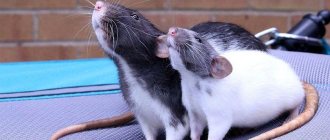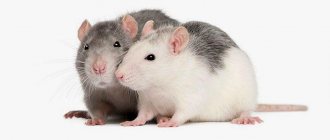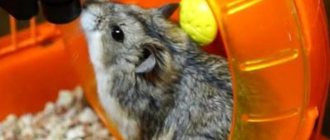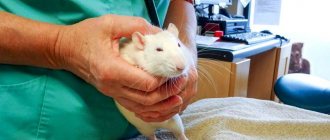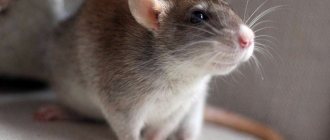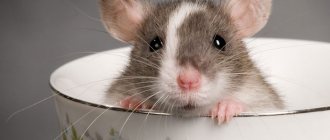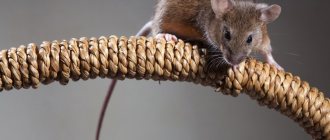The rat is considered one of the most intelligent and cunning species of rodents. And if you are now wincing with disgust and hostility towards this animal, then, most likely, you thought about the inhabitants of garbage dumps and basements, who are capable of carrying a myriad of diseases and infections. Another thing is decorative rodents, which can become an excellent friend for a pet lover in small apartments.
About who rats are, how they behave, what diseases domestic rats have, how to properly care for them, whether it is possible to wash decorative rats and much more - in our article.
Rat as a pet
Whatever animal you choose as a pet, you should remember the responsibility to the animal: it will have to be looked after, fed and loved, regardless of size, activity and type.
Often, future owners of four-legged animals mistakenly believe that if the animal is large, then there is a lot of trouble with it, and if it is small, then it does not require time. But in reality it's not like that. And often a tiny decorative rat requires more care than a huge guard dog. Therefore, if you are not ready to take on a number of responsibilities for caring for an animal, think about whether you want this responsibility or should you wait.
Development of baby rats by day
Rats grow very quickly. After 4 weeks they already become adults, and at 5-6 weeks they reach puberty.
Development of small rodents by day:
- Day 1 - defenseless, blind and deaf babies with underdeveloped limbs and a small tail. They can suckle milk, sleep and squeak a lot.
- Day 3 - ears open.
- 5-6 days - hair appears. The skin color changes from pink to flesh-colored, there are dark spots.
- 8-10 days - the first teeth erupt. The cubs become very active.
- 12-13 days - eyes open.
- 14-16 days - secondary sexual characteristics are formed. The owner can determine the sex of the pups. Females have noticeable nipples on their abdomen.
- 16-17 days - they begin to eat with their mother. They chew everything that surrounds them.
- 20-27 days - rat pups are already formed independent individuals who eat adult food.
- 28-30 days - they are already fully grown. They become very curious, recognize people and love to play with them.
Breeds of domestic rats
Today there are 137 species of domestic rats, as well as 570 subspecies . And each of them is interesting in its own way. The most common:
- breed of decorative rat - standard,
- tailless rats,
- rexes and double rexes,
- satin types,
- hairless,
- decorative dumbo rats,
- downy
At the same time, the color of decorative rats can be uniform, ticked (with a pattern) or combined. White domestic rats, gray domestic rats, and black decorative rats are often found. Less often - with hearts, spots and stripes.
Female care for cubs
An animal of this species is an excellent mother. The female spends around the clock with the cubs, caring for, fattening and taking care of each baby. She uses her own body to cover the children, warming and protecting them.
The warmth that comes from the rat's body and frequent feeding of milk activate the formation of the body systems of newborn rat pups. It is practically impossible to fatten and protect a newborn baby without maternal care.
Keeping a rat at home
If you have no doubts about your decision to have a rat as a pet, be sure to find out all the features of keeping this type of rodent in your home.
For example, a rat has a very direct relationship with rodents - therefore, walking around the apartment, it will find something to chew on: from shoe laces to equipment wires. In this regard, the animal is either not allowed to go on such walks unattended, or all dangerous or valuable objects are removed in advance.
The second feature of the rat is its smell, which indicates the mark of the territory of residence. Ask yourself, are you ready for fragrant surprises?
Thirdly, rats are afraid of drafts and direct sunlight - you need to remember this when placing your pet’s cage (i.e., a window sill is definitely not a suitable place).
Please note that the comfortable air temperature for a rat is 18-21 °C (despite the fact that the body temperature of a decorative rat is higher than a human one - 38.3-39.3 degrees).
Cell selection
The best home for such a rodent is a large and spacious cage (not a jar, not a container or a box). You can buy it at any pet store - complete with ladders, house, feeder and drinking bowl or separately from them. Some owners make accessories for their pets with their own hands (let us just remember that plywood and cardboard are chewed off quite quickly, and the item will have to be replaced). Of course, the animal will really like and will not get bored with such elements as hanging shelves, a running wheel, swings, and branches that can be climbed. This will be especially appreciated by young individuals, but the “oldies” do not need so much entertainment when decorating the interior of the cage.
When choosing filler for the cage, give preference to large sawdust (small particles of wood species can get into the animal’s eyes, nose or ears and cause an allergic reaction). If you use paper as a bedding, it should be clean, without paint, writing or typography.
Cotton wool is not suitable as a filler!
The cage must be cleaned at least once a week. Be sure to do a complete disinfection to eliminate the risk of infecting your rat with parasites, bacteria and microbes that may appear in a dirty cage.
Nail trimming
Rats have sharp toenails; trim them every 1-2 months. Trimming the nails is not difficult, but the rat will likely object and try to escape. If necessary, use human nail clippers to trim the tip a little. Avoid the pink (quick) part that may be visible inside the nail; there are blood vessels and nerves here.
If you cut a blood vessel, apply a little cornstarch to the tip of your nail to stop the bleeding. At the same time as you check your nails, try to take a quick look at your teeth to make sure they are not overgrown. Provide rats with plenty of opportunities (using wooden blocks and toys) to chew; this will keep their teeth short and healthy.
What to feed your pet rat?
It is not enough to know about the care and maintenance of a pet rat: feeding is an equally important aspect, because the pet constantly needs clean and fresh water and food. For liquids, a drinking bowl is placed so that the water does not spill and the cage does not become dirty and damp. The water needs to be changed every day.
The food should include grains (oats, wheat, millet, barley), fruits (apples, bananas, peaches, apricots, persimmons), berries (grapes, strawberries, raspberries), vegetables, herbs (dandelion and plantain leaves), dried fruits , nuts (except almonds) and chicken bones (necessary for grinding teeth). You can give meat, but in small portions and no more than once a week.
The normal feeding frequency is 2 times a day for adults, 3-4 times for children and adolescents.
Additionally, owners purchase a mineral stone that can provide the animal with the necessary amount of calcium.
List of prohibited products:
- roast,
- salty,
- smoked,
- fatty,
- spicy,
- cold,
- sweet.
So candy, chocolate, sausage, bread, soy are not an option. Vegetables such as cabbage, turnips, radishes, radishes, beets, legumes and raw potatoes should not be given. All permitted vegetables and fruits must be ripe (not green, but not overripe). Do not offer your rat leaves from indoor plants or fruit trees.
A properly selected diet is the key to animal health. It’s easy to put together if you know what pet rats eat and what you should absolutely not give.
Cell
The purchase of a cage must be approached with special responsibility, since the rat will spend most of its time in it. When choosing a home for a rodent, you need to pay attention to the following parameters:
- Material of manufacture . Metal is considered the best option, since plastic can be damaged by rat teeth over time. In addition, plastic releases toxic substances, and a long stay in such a cage can negatively affect the health of the animal.
- Safety . All rods must be carefully processed and rounded so that the fluffy does not get hurt. For small rats, the distance between the twigs should vary between 5-9 mm. When keeping adult individuals, a larger clearance is allowed - 10-12 mm. Such parameters will not allow the animal to stick its head between the bars and get stuck.
- The presence of a pallet is necessarily removable. This device will allow you to carry out high-quality and quick cleaning inside your home.
- Size . To keep one or two pets, a cage with an area of 2400 cm 2 will be enough. As the number of animals increases, the housing parameters should correspondingly increase.
- Orientation . If you plan to buy males, it is better to choose a wide horizontal cage to keep them. For more active females, multi-tiered vertical models are recommended.
Sometimes rat owners use a regular aquarium to keep them. In such conditions the animal feels very uncomfortable. There is no sufficient ventilation in the aquarium, so the animal is forced to live in a constant lack of oxygen. This often causes the premature death of pets.
Diseases of decorative rats
Rats, like many other decorative rodents, can be overtaken by a variety of diseases, some of which are dangerous for humans. The causes of illnesses can be parasites, bacteria, viruses, fungi.
The following diseases are common:
- ectromelia (also known as smallpox) is a virus that, when it falls into the animal’s body, multiplies on the skin and internal organs (in the chronic form, ulcers, swelling and spots appear on the skin, which ends in tissue necrosis and gangrene; in the acute stage, there may be no symptoms, but the rat will die within 24 hours);
- listeriosis is a bacterial infection that is also dangerous for humans (infection occurs through bedding, food and cage accessories); body temperature rises, coordination is impaired;
- salmonellosis is a bacterium manifested by apathy, diarrhea, intermittent breathing, and without treatment it turns into edema, paralysis and irreversible organ damage (treated with antibiotics - chloramphenicol, biseptol, sulfadimethoxine);
- pneumonia - damage to the respiratory system by pathogens coronavirus and Sendai virus, manifested by discharge from the nose and eyes, sneezing, difficulty breathing, redness of the eyes, swelling of the throat, apathy, weight loss (treated with a course of antibiotics, anti-inflammatory drugs, immunomodulators and vitamins);
- mycoplasmosis - a genital, respiratory or mixed infection, manifested by enlarged lymph nodes, nasal discharge, pneumonia (the genital form may be asymptomatic);
- coccidiosis - a disease of the intestines and liver with frequent digestive disorders, jaundice, exhaustion;
- scab and actinomycosis are a fungus that enters the rat’s body after flea or tick bites, as well as through contaminated food (symptoms are ulcers, grayish blisters, scabs on the skin, hair loss, abscesses on the mucous membranes in the mouth).
Many diseases can be avoided if you wash your hands after handling your pet, give proven food and keep the animal’s cage clean.
Now you know how to care for a rat at home. Following all the recommendations is not very troublesome, but your smart animal will definitely thank you with its attention and love.
General health problems
Rats can develop many of the same problems as cats, dogs, and even humans. Possible problems range from tumors to respiratory or digestive diseases and neurological problems. Although it is physically possible to perform surgery on a rat, few owners are willing to pay for it, so disease prevention is the best option. If possible, find an exotic veterinarian in your area (a veterinarian with experience treating unusual pets) and schedule an initial appointment to gather baseline health data. A checkup every six months is the best step towards preventing or treating the disease.
Bumblebee (ulcerative pododermatitis) is a painful condition in rats that causes ulcers on the soles of the animals' feet. If left untreated, it can be fatal. This condition usually develops when a small wound on the foot becomes infected with Staphylococcus aureus or E. coli.
Food and treats
To raise a healthy rat, you need to provide your pet with a balanced diet. The daily menu of a rodent consists of 50-60% carbohydrates, 20-30% proteins, and 10-20% fats. Choosing the optimal diet for a fluffy on your own is quite problematic. Therefore, it is better to stock up on specialized food. For example, Beaphar Xtravital, Benelux Funny Premium, Versele-Laga Rat Nature.
It is also recommended to pamper the rat with special treats for rodents - snacks, vegetable pads, currant branches. You can also offer some food from your table as a treat: boiled shrimp, meatballs, fermented milk products, nuts, fresh fruits, vegetables, berries.
Cloth
Nowadays it is fashionable to dress up not only cats and dogs, but also rats. More and more pet stores offer owners of decorative rodents miniature dresses, T-shirts, overalls, as well as stylish leashes.
To create a unique style for your pet, you can not only buy ready-made clothes, but also sew or knit them yourself. Fortunately, there are now a lot of tutorials on how to make outfits for animals. Owners of Sphynxes should especially think about replenishing their wardrobe - after all, in winter these babies get very cold.
As you can see, once a rat appears in the house, you will need to purchase a lot of things necessary for its comfort. In order not to waste your money, you need to clearly know what you need to buy for your rat. Once in comfortable conditions, the newly adopted pet will definitely thank the owner with love and affection.
Source
Birth of the brood
After giving birth, the rat can eat the entire litter, experiencing stress! To prevent this from happening, you should:
- do not touch or look at babies;
- do not touch the female;
- remove play accessories from the cage;
- put paper napkins in the cage;
- There is no need to clean the home, you can only pick up heavily soiled pieces of napkins so as not to accidentally destroy the nest;
- Monitor the availability of food and water.
The number of offspring may depend on the species to which the female belongs; for convenience, consider the table:
| View | Duration of pregnancy | Duration of the lactation period | Number of litters | Number of cubs |
| White rat | 20-25 | 21-23 | 5 | up to 20 |
| Gray rat | 20-25 | 22-23 | 5 | up to 20 |
| Black rat | 20-25 | 22-24 | 5 | up to 7 |
Caring for newborn rat pups
It happens that the female does not care for newborn rats, there are several reasons for this: the litter is too large, or if the cub cannot get to the milk, as well as other reasons. In this case, caring for the little rats falls on the owner.
During the first days there is no need to touch the mother and babies, but after a while you can start getting to know the offspring. According to the advice of experienced rat breeders, if the newborns are introduced to each other before they open their eyes, then the rats grow up to be very outgoing and sociable.
For the first couple of weeks, newborn rat pups eat only their mother's milk. Rats older than this age begin to show interest in solid foods and begin to understand tastes.
What to feed baby rats
Let's look at the feeding table for newborns by week:
| 1st week | 2nd week | 3rd week | 4th week |
| mother's milk or formula every 2-3 hours | mixture with grain feed, every 4 hours and once at night | the mixture with grain feed is poured into a bowl, night feeding is canceled | switching to dry food |
Also, up to 6 weeks of age, drinking cow's or goat's milk using a pipette is allowed. If the female feeds the babies with breast milk, then from the age of one month they, together with their mother, switch to regular food; the following can be added to the diet of newborns:
- dairy products;
- fruits;
- candied fruits, etc.
Tray
The tray is a corner container made of ceramic or plastic. As a rule, rats completely ignore this element of the interior. However, some disciplined individuals (especially females) go to the toilet in the same place.
In any case, it is necessary to at least try to accustom the rat to the tray. To do this, you will need to ensure that the rodent goes to the toilet in the designated area at least once. With the next urge for relief, the animal will be guided by the smell and go to relieve itself in the tray.
Feeders and drinkers
Since rats are fed not only with industrial food, but also additionally fed, for convenience it is better to purchase 2 feeders. One is for ready-made store formula, the second is for complementary feeding. Externally, feeders look like small bowls. Depending on the material of manufacture, the following types are distinguished:
- metal - suitable only for calm, neat pets, since metal dishes make a lot of noise;
- plastic ones have one drawback: they are very light, so animals often turn over such feeders, making a mess in the cage;
- ceramic ones are the best option; such bowls are quite heavy and do not rattle during the furry meal.
House
Under natural conditions, wild rats prefer to hide from enemies in shelters. Therefore, their domestic relatives also need a secluded corner for privacy. Without shelter, rodents feel vulnerable and experience severe stress. You can buy a house at a pet store or make it yourself from the following materials:
- Cardboard . Suitable for temporary structures only. Because the rat will simply eat it. A cardboard structure will not last even a week in a cage.
- Tree . An excellent option: durable, and most importantly, environmentally friendly. However, it has a significant drawback - wooden floors and walls absorb and retain rat urine well. Therefore, wooden houses will have to be replaced quite often.
- Plywood . Also a good option, but the material also has good absorbency. In addition, when making a house from plywood you will have to use glue, which can be toxic to rats.
- Plastic . It is considered the best option. The plastic house is quite durable and easy to clean.
- Textiles . Most rats prefer a hammock to a house.
When making or purchasing a house, you need to pay attention to its parameters. Animals should be able to easily rest in it. And also stand without resting your head on the ceiling.

